diy: circle skirt sew-along - hemming
Wow—can you believe we are this close to being finished with our circle skirts? I hope you all have enjoyed making these; I always forget how quickly the style comes together until I get to the end and think “Am I done already?”. Today I have three hemming options for you; you can pick which one will suit your fabric best. These, of course, are not all the hemming techniques possible for a circle skirt, but the ones I tend to favor. So feel free to deviate if you have another method you prefer!
First, before you even touch the hem, you’ll want to let the skirt hang for about 24 hours. Because of the bias element in the skirt, this can sometimes stretch a bit, and you want it to stretch now, rather than after you’ve hemmed the skirt. Try the skirt on post-stretching, and mark the hem an even distance all around from the floor. My favorite way is to use the handy hem marker I picked up a few years ago at a rummage sale (they’re still available though). But you can also have someone else mark the hem evenly around the bottom using a ruler/yardstick. Use pins spaced every few inches to mark where your hem will be. (Or try this solo-marking technique.) Just keep in mind you’ll need at least 5/8” below that pin for the actual finishing of the hem.
Take the skirt off and measure down from each pin 5/8” (or more, if you’d like a deeper hem. But stay about 1” or less.), and mark the cutting line. Trim the hem following those cutting-line marks. I usually find it helpful to baste the hem fold-line in at this stage, which can be done on machine.
Non-Woven Hem
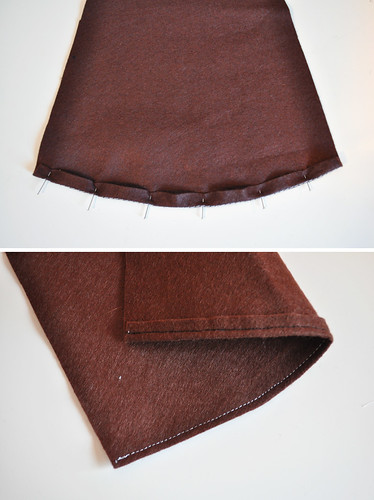
Turned-Up Hem
This is just your basic hem, turned back an stitched by hand (or machine—though I only recommend that for casual styles and non slippery/thick fabrics). The real trick is how the raw edge is finished.
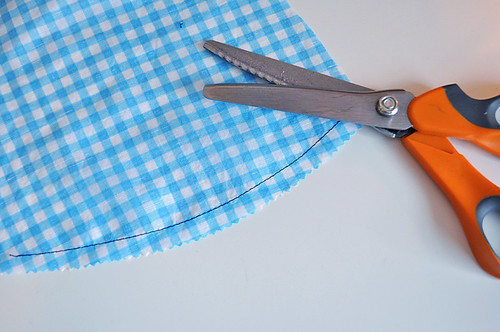
For firmly-woven fabrics and casual styles, you can get away with pinking the edge, or serging/zig-zagging over the raw edge. (Use thread that matches your fabric as closely as possible, so if the hem flips up it won’t be as noticeable.) Keep in mind that if you’re working with a wider hem, you may have to ease the top edge a little to conform to the curve of the skirt, and prevent those folds/tucks that can warp the finished hem edge.
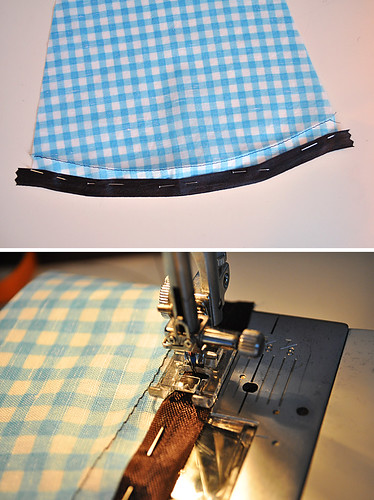
Another method of hem finishing would be to use a narrow seam binding or hem lace to cover that raw edge. You’ll need to make sure your hem is fairly narrow (1/2” to 5/8” at most), to avoid the puckering/excess ease I mentioned above. You can finish the raw edge if you’re working with a fabric that likes to ravel a lot, and them lap the tape over the hem (wrong side of the tape to the right side of the hem) by about 1/4”. Straight stitch over the area where the hem and tape connect, being sure to turn under the tape at the end, and overlapping the starting raw edge (for a neat finish).
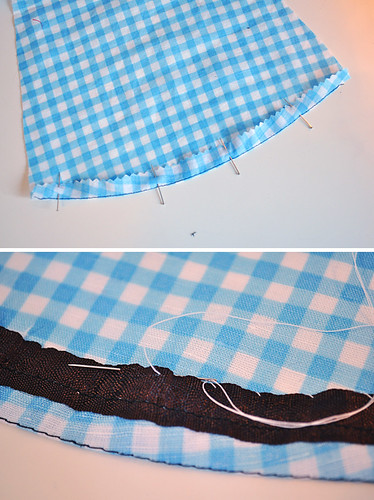
Once you have determined how to finish the edge, turn the hem to the inside of the skirt along the basted hem-fold line. Pin. You can either evenly machine stitch around the hem (use a slightly wider stitch for this), or you can slip or catchstitch the hem to the inside of the skirt. Hand hemming may seem daunting on a circle skirt (be prepared to spend a few evenings doing it), but the result is far more subtle and soft—suited to fabrics whose surfaces show machine stitching too easily.

Machine Rolled Hem
This is my favorite hem for a circle skirt, and one that is recommended in a few of my sewing books. This will work well on most light to medium weight fabrics. You will need a hem of 5/8” wide for this.

Begin by staystitching 3/8” from the raw edge of the hem. Press the staystitching to steam out any ease in the hem curve. Press the hem to the wrong side of the skirt along this staystitching. Pin if necessary.
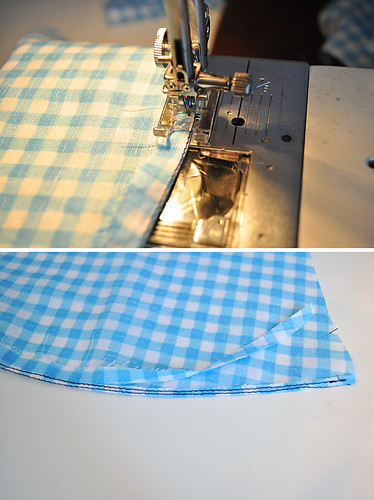
Stitch 1/8” away from the fold line along the hem. This can be tricky with slippery/thin fabrics, so go as slowly as you need! Trim the excess above this line of stitching, right alongside the stitching line, trimming as close as you can (without clipping the stitches of course!). If you have a pair of applique scissors, this makes the process go a lot quicker.
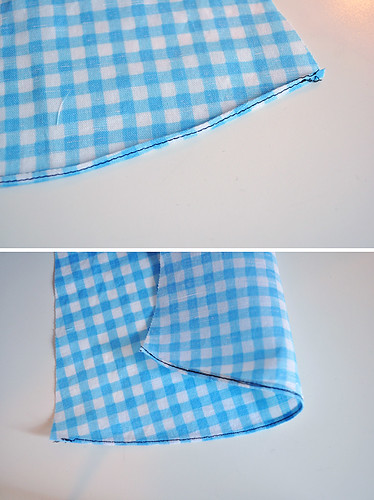
Fold the hem again (to the wrong side of the skirt) a scant 1/4”. Press and pin if needed. Stitch 1/8” from the hem fold around the entirety of the hem. Press again.
Horsehair Braid Hem
This is probably the hem I’m most excited about right now, since this sew-along gave me an excuse to finally try it! If you want a skirt that has some form and structure without wearing a net petticoat, this is the way to go. You’ll need horsehair braid, though (Sunni of A Fashionable Stitch kindly sent me some to try out for this!), which can be a bit tricky to find at your local fabric shop (unless you live in a big city with good fabric stores).
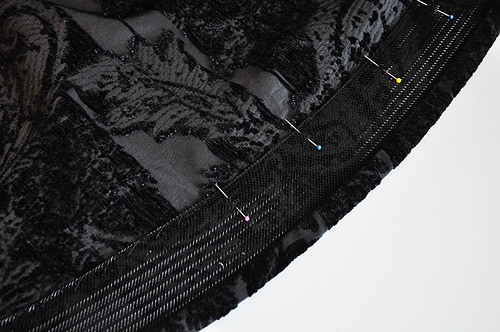
Rather than reinvent the wheel, I’m going to direct you to Gertie’s excellent tutorial and follow-up post. This is the basic technique for apply horsehair braid to a simple hem. For my skirt, I opted to forgo the machine topstitching along the top edge, and instead am using a hand-worked catchstitch to secure the top edge of the braid to the skirt. (Yes, it’s taking a bit but the result is hardly noticeable on the right side!) Let me just tell you: I am completely in love with how full the hem is!
That’s it for the construction of your circle skirt! Post-hemming give it a good press and step back to admire your handwork. I’m going to try to get my petticoat made and a tutorial written up over the weekend, and posted next week. If not, I’ll just have a round-up of tutorials online to direct those of you who want to make your own. Then it’ll be time for the circle skirt party! Stay tuned for details…

Comments
Post a Comment
Thank you so much for taking time to comment! I LOVE hearing feedback from readers. I welcome truly constructive and thoughtful critique and suggestions, but will not hesitate to delete spam or downright rude comments.